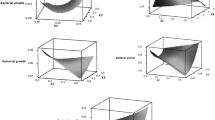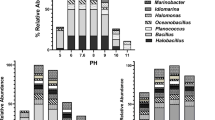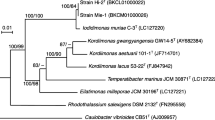Abstract
The present study has been conducted towards isolation of moderately halophilic bacteria capable of transforming caffeine into theobromine. A total of 45 caffeine-degrading moderate halophiles were enriched from hypersaline lakes and examined for the biotransformation of caffeine to theobromine by thin-layer chromatography (TLC) and high-performance liquid chromatography analyses. Strain GL6, giving the highest yield of theobromine, was isolated from the Hoz Soltan Lake, 20 % w/v salinity, central Iran, and identified as Salinivibrio costicola based on morphological and biochemical features as well as its 16S rRNA gene sequence analysis (GeneBank Accession No. KT378066) and DNA–DNA relatedness. The biotransformation of caffeine with strain GL6 leads to the formation of two metabolites, identified as theobromine and paraxanthine, but the yield of paraxanthine was much lower. Further study on the production of theobromine from caffeine under resting cell experiment was carried out subsequently. The optimal yield of theobromine (56 %) was obtained after a 32-h incubation using 5 mM of caffeine and 15 g l−1 (wet weight) of biomass in 0.1 M saline phosphate buffer (pH 7.0 and 10 % w/v NaCl) under agitation 180 rpm at 30 °C. The biotransformed theobromine was purified by preparative TLC and subjected to FTIR and mass spectroscopy for chemical identification. This is the first evidence for biotransformation of caffeine into theobromine by strains of the genus Salinivibrio.



Similar content being viewed by others

References
Abdelkafi S, Sayadi S, Ben Ali Gam Z et al (2006) Bioconversion of ferulic acid to vanillic acid by Halomonas elongata isolated from table-olive fermentation. FEMS Microbiol Lett 262:115–120
Amoozegar MA, Schumann P, Hajighasemi M et al (2008) Salinivibrio proteolyticus sp. nov., a moderately halophilic and proteolytic species from a hypersaline lake in Iran. Int J Syst Evol Microbiol 58:1159–1163
Asano Y, Toshihiro K, Yamada H (1993) Microbial production of theobromine from caffeine. Biosci Biotechnol Biochem 57:1286–1289
Ashihara H, Monteiro AM, Moritz T et al (1996) Catabolism of caffeine and related purine alkaloids in leaves of Coffea arabica L. Planta 198:334–339
Barcz E, Sommer E, Janik P et al (2000) Adenosine receptor antagonism causes inhibition of angiogenic activity of human ovarian cancer cells. Oncol Rep 7:1285–1291
Blecher R, Lingens F (1977) Metabolism of caffeine by Pseudomonas putida. Hoppe Seylers Z Physiol Chem 358:807–817
Christ C (2008) Production-integrated environmental protection and waste management in the chemical industry. Wiley, Hoboken
Dash SS, Gummadi SN (2007) Degradation kinetics of caffeine and related methylxanthines by induced cells of Pseudomonas sp. Curr Microbiol 55:56–60
Garcia MT, Ventosa A, Ruiz-Berraquero F et al (1987) Taxonomic study and amended description of Vibrio costicola. Int J Syst Bacteriol 37:251–256
Gluck M, Lingens F (1987) Studies on the microbial production of thebromine and heteroxanthine from caffeine. Appl Microbiol Biotechnol 25:334–340
Gokulakrishnan S, Chandraraj K, Gummadi SN (2007) A preliminary study of caffeine degradation by Pseudomonas sp. GSC1182. Int J Food Microbiol 113:346–350
Gorriti MF, Dias GM, Chimetto LA et al (2014) Genomic and phenotypic attributes of novel salinivibrios from stromatolites, sediment and water from a high altitude lake. BMC Genom 15:473
Gunasekaran S, Sankari G, Ponnusamy S (2005) Vibrational spectral investigation on xanthine and its derivatives-theophylline, caffeine and theobromine. Spectrochim Acta A 61:117–127
Gutiérrez-Sánchez G, Roussos S, Augur C (2013) Effect of caffeine concentration on biomass production, caffeine degradation, and morphology of Aspergillus tamarii. Folia Microbiol 58:195–200
Hallstrom T, Wolk A, Glynn A et al (2006) Coffee, tea and caffeine consumption in relation to osteoporotic fracture risk in a cohort of Swedish women. Osteoporos Int 17:1055–1064
Hanamura S, Chikauchi Ken, Kanazawa S et al (2011). Production method for a high theobromine-containing composition. US patent application 20110003834
Heckman MA, Weil J, De Mejia EG (2010) Caffeine (1, 3, 7-trimethylxanthine) in foods: a comprehensive review on consumption, functionality, safety, and regulatory matters. J Food Sci 75:77–87
Huss VAR, Festl H, Schleifer KH (1983) Studies on the spectrophotometric determination of DNA hybridization from renaturation rates. Syst Appl Microbiol 4:184–192
Ibrahim S, Shukor MY, Syed MA et al (2016) Characterization and growth kinetics studies of caffeine- degrading bacterium Leifsonia sp. strain SIU. Ann Microbiol 66:289–298
Kakuyama A, Sadzuka Y (2001) Effect of methylxanthine derivatives on doxorubicin transport and antitumor activity. Curr Drug Metab 2:379–395
Kargul B, Ozcan M, Peker S et al (2012) Evaluation of human enamel surfaces treated with theobromine: a pilot study. Oral Health Prev Dent 10:275–282
Lakshmi V, Das N (2010) Caffeine degradation by yeasts isolated from caffeine contaminated samples. Int J Sci Nat 1:47–52
Leifson E (1963) Determination of carbohydrate metabolism of marine bacteria. J Bacteriol 85:1183–1184
Madyastha KM, Sridhar GR (1998) A novel pathway for the metabolism of caffeine by a mixed culture consortium. Biochem Biophys Res Commun 249:178–181
Mazzafera P, Olsson O, Sandberg G (1996) Degradation of caffeine and related methylxanthines by Serratia marcescens isolated from soil under coffee cultivation. Microb Ecol 31:199–207
Moffat AC (ed) (1986) Clarke’s isolation and identification of drugs, 2nd edn. The Pharmaceutical Press, London, pp 1010–1011
Mohapatra BR, Harris N, Nordin R et al (2006) Purification and characterization of a novel caffeine oxidase from Alcaligenes species. J Biotechnol 125:319–327
Namwong S, Tanasupawat S, Smitinont T et al (2005) Isolation of Lentibacillus salicampi strains and Lentibacillus juripiscarius sp. nov. from fish sauce in Thailand. Int J Syst Evol Microbiol 55:315–320
Nayak S, Harshitha MJ, Sampath MC et al (2012) Isolation and characterization of caffeine degrading bacteria from coffee pulp. Indian J Biotechnol 11:86–91
Nieto JJ, Fernandez-Castillo R, Marquez MC et al (1989) Survey of metal tolerance in moderately halophilic eubacteria. Appl Environ Microbiol 55:2385–2390
Nurminen ML, Niittynen L, Korpela R et al (1999) Coffee, caffeine and blood pressure: a critical review. Eur J Clin Nutr 53:831–839
Oren A (2010) Industrial and environmental applications of halophilic microorganisms. Environ Technol 31:825–834
Quiñones M, Miguel M, Muguerza B et al (2011) Effects of a cocoa polyphenol extract in spontaneously hypertensive rats. Food Func 2:649–653
Ramarethinam S, Rajalakshmi N (2004) Caffeine in tea plants [Camellia sinensis (L.) O. Kuntze]: in situ lowering by Bacillus licheniformis (Weigmann) Chester. Indian J Exp Biol 42:575–580
Retnadhas S, Gummadi SN (2014) Optimization of process conditions for biotransformation of caffeine to theobromine using induced whole cells of Pseudomonas sp. J Bioprocess Biotech 4:178
Sarath Babu VR, Patra S, Thakur MS et al (2005) Degradation of caffeine by Pseudomonasalcaligenes CFR 1708. Enzyme Microb Technol 37:617–624
Schwimmer S, Kurtzman RH (1971) Caffeine metabolism by Penicillium roqueforti. Arch Biochem Biophys 147:109–113
Slattery ML, West DW (1993) Smoking, alcohol, coffee, tea, caffeine, and theobromine: risk of prostate cancer in Utah (United States). Cancer Causes Control 4:559–563
Smibert RM, Krieg NR (1994) Phenotypic characterization. In: Gerhardt P, Murray RGE, Wood WA, Krieg NR (eds) Methods for general and molecular bacteriology. American Society for Microbiology, Washington, DC, pp 607–654
Srivastava KC (1993) Properties of thermostable hemicellulolytic enzymes from Thermomonospora strain 29 grown in solid state fermentation on coffee processing solid waste. Biotechnol Adv 11:441–465
Tamura K, Stecher G, Peterson D et al (2013) MEGA6: molecular evolutionary genetics analysis version 6.0. Mol Biol Evol 30:2725–2729
Usmani OS, Belvisi MG, Patel HJ et al (2005) Theobromine inhibits sensory nerve activation and cough. FASEB J 19:231–233
Wang CY, Hsieh YR, Ng CC et al (2009) Purification and characterization of a novel halostable cellulase from Salinivibrio sp. strain NTU-05. Enzyme Microb Technol 44:373–379
Weisburg WG, Barns SM, Pelletier DA et al (1991) 16S ribosomal DNA amplification for phylogenetic study. J Bacteriol 173:697–703
Zhang M, Xu YJ, Mengi SA et al (2004) Therapeutic potentials of pentoxifylline for treatment of cardiovascular diseases. Exp Clin Cardiol 9:103–111
Acknowledgments
The author would like to thank the Research Vice Chancellor of the University of Kurdistan for offering a Grant No. 3357210351 for this research.
Author information
Authors and Affiliations
Corresponding author
Electronic supplementary material
Below is the link to the electronic supplementary material.
Rights and permissions
About this article
Cite this article
Ashengroph, M. Salinivibrio costicola GL6, a Novel Isolated Strain for Biotransformation of Caffeine to Theobromine Under Hypersaline Conditions. Curr Microbiol 74, 34–41 (2017). https://doi.org/10.1007/s00284-016-1148-z
Received:
Accepted:
Published:
Issue Date:
DOI: https://doi.org/10.1007/s00284-016-1148-z



